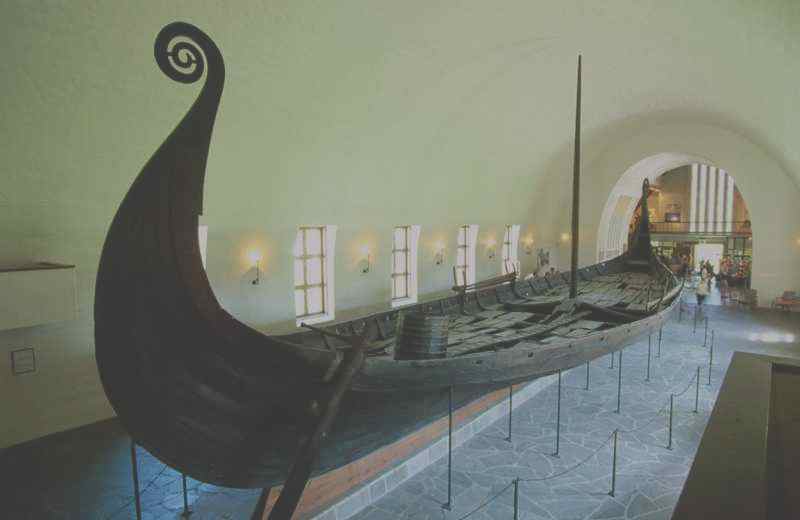Probing Attacks: England, Scotland, and Ireland
Episode #3 of the course Vikings: History and mindset by Tom Shippey
Welcome to Lesson 3!
Yesterday, we talked about that famous English scholar, Alcuin of York, who was utterly horrified when the longships came out of the north. But actually, he might have taken warning from something that happened four years before the raid on Lindisfarne, a small affair recorded in The Anglo-Saxon Chronicle.
Ships from the north—the first that ever sought out England—landed at Portland and killed the port-reeve there. The Chronicle says they were Danes, but a later account, drawing on local information, says that the reeve’s name was Beaduheard (which means “Battle-hard”), that he rode over from the county town expecting to collect the harbor-tax, and that the killers came from Hordaland.

Exhumed Viking ship, in the Viking Ship Museum, Oslo, Norway.
One thing this tells us is that “peaceful-trader” Scandinavians could turn Viking very quickly, if they could get away with it. But it’s odd that they were from Hordaland in Norway, around Bergen, a very long way from Portland on the south coast of England. How did they get there?
Raider Geography
Bergen on the west coast of Norway is on the same latitude as the Shetland islands north of Scotland, two days’ sail to the west. Vikings could easily check latitude from the height of the sun.
Get there, and you can stay in sight of land all the way down the west coast of Scotland, into the Irish Sea, around south-west England, and up the English Channel to Portland. Plenty of places to take on water and follow the old practice of strand-höggr: landing on a beach, stealing a cow, and having a barbecue before the locals could organize defense.
What this suggests is that Vikings had been practicing their raider-skills and their navigation on the small, poorly-armed populations of the north and west of Britain, without anyone important noticing. It was Norwegians who started it off.
The 793 raiders knew exactly where Lindisfarne was. They’d been reconnoitring.
The Descent on Ireland
The next target, though, was the equally famous monastery of Iona in Scotland, which was hit in 795, 802, and 806, after which the monks removed to Kells in Ireland. The Vikings followed them. By 812, Ireland was infested with Vikings, whom the Irish called the Finn-Gaill, the “fair foreigners,” by which they seem to have originally meant Norwegians. Soon, the Dubh-Gaill, “dark foreigners” (maybe Danes), would be there as well.
The two groups hated each other—they were competitors. The most disgusting passage in all accounts of Viking behavior must be one from an Irish chronicle. Irish emissaries turned up to a Viking camp, where Danes had just defeated Norwegians. The Danes were cooking on the bodies of the dead:
And the fire was burning the bodies, so that the meat and fat that [the dead Norwegians] had eaten the night before was bursting out of their bellies.
The Irish said this was uncivilized behavior, but the Danes just answered, “They would like to have us like that.”
Liberal historians (as usual with accounts of Viking atrocity) have preferred not to believe this. But the “so what?” attitude is very much in line with the Viking mindset.
A Confused Situation
Ireland then turned into a multi-combatant dogfight. Ireland itself consisted of as many as 150 petty kingdoms, all used to fighting each other, while the southern and northern O’Neill clans competed for the High Kingship of Ireland. The Irish hired Vikings, the Vikings took Irish allies, and Vikings fought each other. They’d fight for/against anyone if the pay was right.
Worst of the lot were the mixed-race people the Irish called Goidhil-Gaill, or “Irish foreigners,” who soon had a reputation for special barbarity. The Irish hated them for abandoning Christianity, while in Norse sagas, a stock character is the chip-on-the-shoulder Hiberno-Norseman, whom nobody liked.
Pretty soon, though, the situation was going to be clarified, in Ireland and Scotland and England as well, by the activities of one man: Ivar the Boneless, son of Ragnar Hairy-breeches. His descendants, the Ui-Imhair, or “O’ Ivar” dynasty, dominated Irish politics for generations. Neither modern England not Scotland would be the same without him. He is the subject of the next lesson.
Recommended reading
Information about Five Viking Ships in the Viking Ship Museum (Roskilde, Denmark)
Recommended book
Viking Kings of Britain and Ireland: The Dynasty of Ivarr to AD 1014 by Clare Downham
Share with friends
